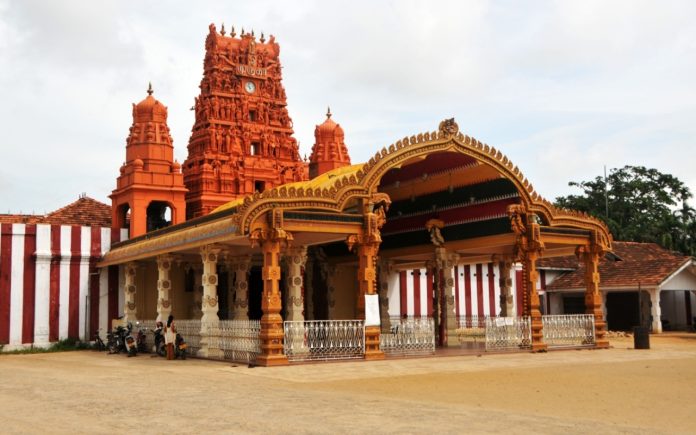[ad_1]
The northern peninsula of Sri Lanka is a unique mosaic of natural beauty and historical significance. Its pristine beaches, rich cultural heritage, and tranquil ambience are captivating. The region is experiencing a revival, emerging from the shadows of conflict and decades of isolation. The world is uncovering its hidden treasures, eclectic and fascinating. From its diverse islands to ancient and colourful shrines, the northernmost part of the island offers a rich tapestry of history, culture and natural beauty. So, are you ready to explore this barely untouched part of the island?
Nallur Kandaswamy Kovil
It is one of the most significant Hindu temples in the country. Dedicated to Lord Murugan, also known as Skanda, the Hindu god of war, the temple architecture never fails to wow visitors. Its deity-adorned umber gopuram towers over the landscape. The inner sanctum has ornate statues of a pantheon of gods, including Murugan, the chief deity. Colonnades, pillared halls decorated by life-size murals and intricate brasswork and a stepped holy pool embellish the temple complex. A sacred tree provides shade in the southern courtyard of the temple.
First built in 948 A.D., the temple was relocated several times around Nallur due to foreign invasions. In the 15th century, King Parakramabahu VI developed the temple, and later, his adopted son built the third Nalluru Temple after his conquest of Jaffna. The current and fourth temple dates back to 1734 A.D. during the Dutch colonial era.
You can witness daily pujas, various rituals and colourful festivals held here. It hosts the longest Hindu festival on the island – Nallur Festival in midsummer (July, August or September, according to the Tamil Calendar). The 25-day celebration brings vibrant processions, dancing, drumming, and more to the streets.
Keerimalai Naguleswaram Temple
The temple is from classical antiquity and the northernmost Pancha Ishwarams of Lord Shiva. These are five kovils found along the circumference of Sri Lanka. Located on the Mongoose Hill (Keeri-malai), its mineral water springs are said to have healing powers. King Ravana, a devotee of Shiva, placed lingams in each of the five Pancha Ishwaram kovils.
After the epic war in Ramayana, on his way back to India, Ram stopped here to bathe in the waters. Rama also visited other Ishwaram temples. In doing so, he cleansed himself of the sin of killing Ravana. The Yaksha Queen Kuveni of Lanka, a descendant of Ravana, also venerated Ishwara in the form of Shiva.
Kadurugoda Temple ruins
These ancient Buddhist temple ruins are singular. 20 grey coral-stone dwarf stupas sprawled across less than an acre of land punctuated by Palmyra trees offer a curious glimpse into the past. There used to be nearly 60, according to official records from the 1900s. Legend says that when Sangamitta arrived at Dambakolaptuna with the sacred sapling of Sri Maha Bodhi, the envoy made their way to Anuradhapura through this site. She was known to have stopped at the temple on her way. Stories about the site vary. Most stories say the little stupas are tombstones of mushroom-poisoned monks, and others say they died due to famine.
Dambakola Patuna
Also known as the Port of Jambukolapattinam, this ancient port is where Sri Lanka received the sacred sapling of Sri Maha Bodhi from India. Brought to the island by Emperor Asoka’s daughter Sangamitta, it is one of the most historic places on the north coast. Although the ancient shrine and sacred fig trees are no longer here, a newly erected temple and statue mark this significant place.
Chundikkulam National Park
Previously a bird sanctuary, it is upgraded to national park status. Chundikkulam Lagoon sits surrounded by mangrove swamps and sea grass beds. The surrounding area includes dunes, salt marshes, palmyra palm plantations, scrub forests and dry zone flora. A variety of water birds and waders thrive here. These include flamingoes, painted storks, pelicans, spoonbills, godwits, ducks, pelicans, gulls and sea eagles. Mammals such as sloth bears, jackals, deer, Mugger crocodiles and saltwater crocodiles also live in the park.
Nainativu or Nagadeepa
Take the ferry to Nagadeepa, one of the 16 holiest Buddhist sites on the island and one of the most visited islands of Jaffna. According to scripture, Buddha came here to resolve a dispute between two naga kings caused by a bejewelled throne. Nagadeepa Purana Vihara is a shrine of reverence to the incident.
The Nagapooshani Amman Kovil on the island is one of 64 Shakti Peethas scattered across South Asia. These are ancient shrines dedicated to Hindu goddesses. The Kovil venerated goddess Parvati. The island is a symphony of sea birds, temple bells, incense, chanting, motifs, sculpture and a blend of Buddhist and Hindu religious artistry.
Jaffna Fort
Scale up the preserved ramparts of the Jaffna Fort to savour the ocean view like the old-world Europeans. Built by the Portuguese in the 17th century, the Fort sprawls over the southeastern edge of Jaffna. The Dutch, capturing it from the Portuguese, expanded it into its current proportions. Following the departure of the Dutch, the British turned it into a stronghold until the independence of Sri Lanka in 1948.
The authentic north of Sri Lanka with Blue Lanka Tours
The unique charm of Jaffna is in its unassuming beauty. It is unspoilt, uncrowded and uncommercialised. Only those who know it well know its allure. Its muted promotion is a quiet invitation to discover it yourself. Enrich your Sri Lankan experience by not missing out on the low-key region many miss on the tourist circuit. We are big on bringing authenticity and unique perspective to travel. At Blue Lanka Tours, we craft memorable holidays for every wanderlust soul. Tailormade with attention to every detail, you can rely on us for hassle-free, comfortable and responsible travel from start to finish. We are at your service 24/7. Would you like to discover Jaffna on your Sri Lankan tour?
[ad_2]
Source link


